Table of Contents
Locomotion and Movement: The chapter on locomotion and movement has one of the highest weightages in the biology section of the NEET exam. So, mastering this chapter becomes even more important from the NEET examination point of view. The locomotion and movement chapter of NCERT Biology deals with the different types of movement, mechanism behind the muscle contraction and relaxation, and other related concepts. This article will give you a detailed explanation of this chapter in a one-shot video so that you can be fully prepared for every concept that can be asked in the exam. Our expert faculty of NEET at Adda 247 has also made a detailed PDF note on this chapter so that students can refer to it when required.
Locomotion and Movement
Locomotion & Movement is a crucial concept in biology that comes under the ambit of human physiology. Two key concepts in the study of motion are locomotion and movement, which are essential characteristics of all living things. Every living thing, with the exception of plants, travels for a number of reasons, including food, shelter, avoiding predators, and escape. Although they are distinct from one another, the terms “motion” and “locomotion” refer to the same thing. These locomotion and movement are aided by the muscular and skeletal system of our body. The detailed explanation of these concepts have been provided in the subsequent sections in the form of PDF notes and expert faculty video.
Locomotion and Movement Class 11
Locomotion & Movement chapter is one of the most favorite chapters of examiners from the class 11th Biology NCERT. This chapter contains a number of information about different types of bones, joints and muscle fibers, it helps examiner to frame different variety of questions for the competitive as well as school exam. This chapter features at chapter number 20 in the Biology NCERT textbook of class 11th. The knowledge of this chapter will help students in different examinations at various levels.
Locomotion and Movement Class 11 NCERT Overview
The NCERT Class 11 Biology chapter on locomotion and movement explores the amazing systems that enable living things to move. Understanding this chapter can help you on the NEET exam as well as the class 11 exams. Numerous crucial ideas, like the action of muscles and the composition of bones, are covered in this chapter. Comprehending these mechanisms is essential to appreciating the complexities of life and the ways in which adaptations have changed across time.
Locomotion and Movement NCERT Importance for NEET Exam
Locomotion and Movement is an important chapter for the NEET examination. Every year, 4-5 questions are asked from this chapter in the NEET exam. Preparing this chapter will fetch 16-20 marks in the NEET exam, which will help NEET aspirants a lot. This chapter has the highest weightage in the human physiology subsection of the Class 11 NCERT Biology. As most of the concepts in the biology section of NEET UG comes directly from the standard NCERT text book, it is important to memorize all the concepts of this chapter from NCERT. Learning this chapter fully will help students in increasing their NEET score by up to 20 marks. To help students in their NEET journey, all the important NCERT notes along with extra notes relevant for NEET UG exam on this chapter is given below for students in PDF form. There is also a video by top-,most NEET expert faculty of the country at ADDA 247 for detailed preparation of this chapter, where students can clear all their doubts.
Locomotion and Movement Notes PDF for NEET
The NEET Biology syllabus’s key notes for the chapter on locomotion & movement is given hereunder in the PDF format. Aspirants preparing for the NEET and other exams can view and download this link by clicking on the PDF link. This PDF will be useful for the exam preparation as well as last-minute preparation of students. All of the key subjects and ideas that are relevant to the exam are covered in the NEET Biology: Locomotion and Movement crucial notes. Apart from the notes, the PDF also contains important NEET questions (MCQs), so that students can practice and learn this chapter fully.
Locomotion and Movement Notes PDF for NEET
Locomotion and Movement Notes
Some of the important topics of locomotion & movement and their brief explanation is given below. Students should go through the video and PDF link given in this article to learn all the concepts of this chapter.
Different Types of Movement
- Amoeboid movement: This movement resembles that of pseudopodia in amoeba. Amoeboid movement is seen in macrophages, leukocytes, and even cytoskeletal microfilaments.
- Flagellar and Ciliary Movement: Ciliary movement in the lining of the trachea, reproductive tract, etc., and flagellar movement in other tissues. Sperm exhibit flagellar motion.
- Muscular movement: In a multicellular organism, muscles are primarily responsible for movement. The muscles in our body are responsible for breathing, heart function, digestion, appendage movement, and locomotion. The coordinated movement of the brain, muscular, and skeletal systems is known as locomotion.
Different Types of Muscles
Cardiac Muscles: They are striated, involuntary muscles and are found within the heart.
Visceral Muscles: They are non-striated and smooth. Additionally, they are involuntary, sustain a variety of internal organs, and participate in a number of processes like reproduction and digesting.
Skeletal Muscles: They are striated, voluntary muscles and are in charge of limb movement and locomotion.
Skeletal Muscles Composition
The most common type of muscles are skeletal muscles. They consist of connective tissue encircling bundles of muscle fibers. The different components of this muscle is illustrated below.
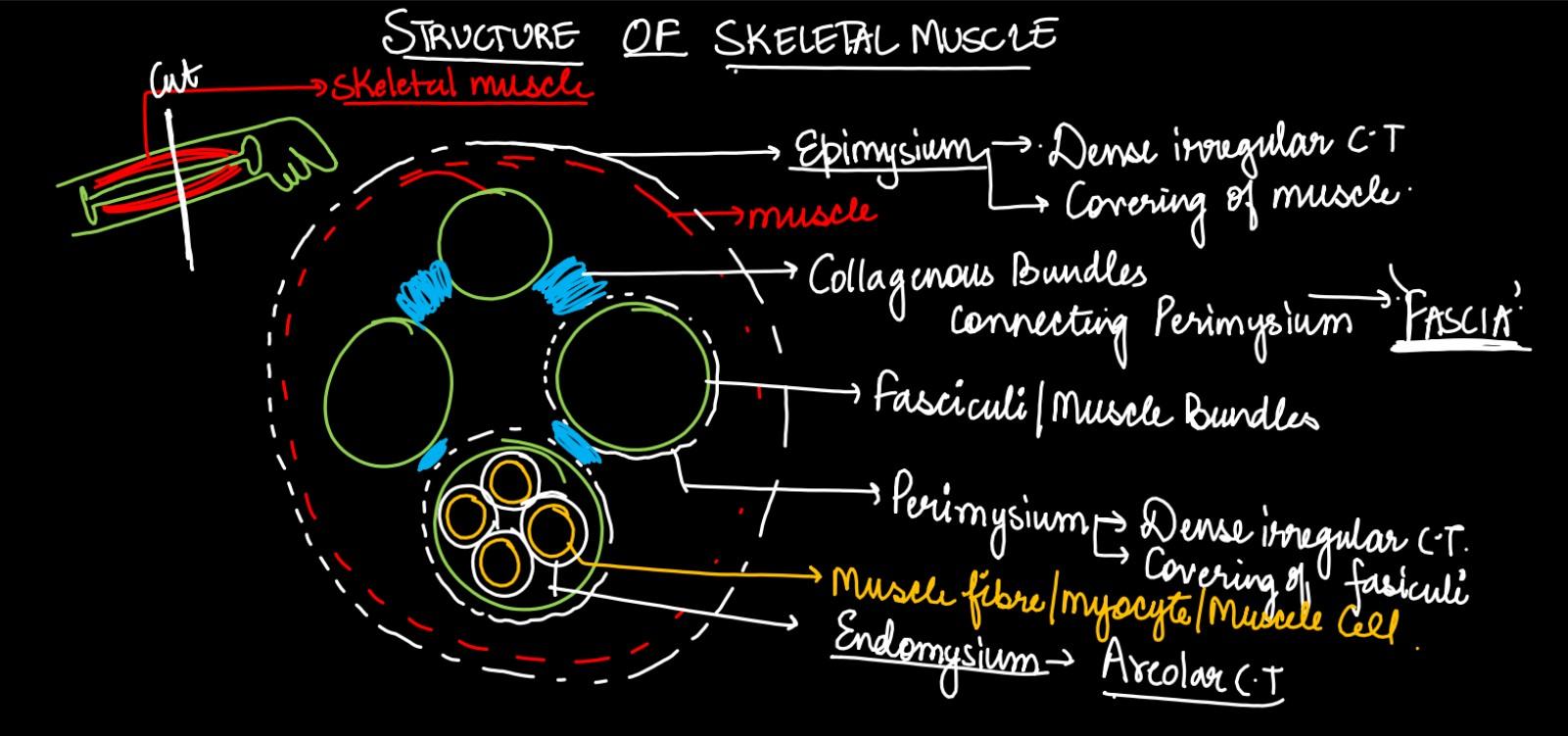
Muscle Proteins
Muscle proteins play an important role in the movement of muscles. These proteins are divided into two categories.
1) Contractile Proteins: The contractile proteins are of two types – Actin (also known as thin filament) and Myosin (thick filament).
2) Regulatory Proteins: These are again of two types – Tropomyosin and Troponin
Sarcomere
Sarcomeres are end-to-end linked strands of protein found in myofibrils. Muscle contraction begins in the sarcomere. It has a structured arrangement of repeated actin and myosin filament units.
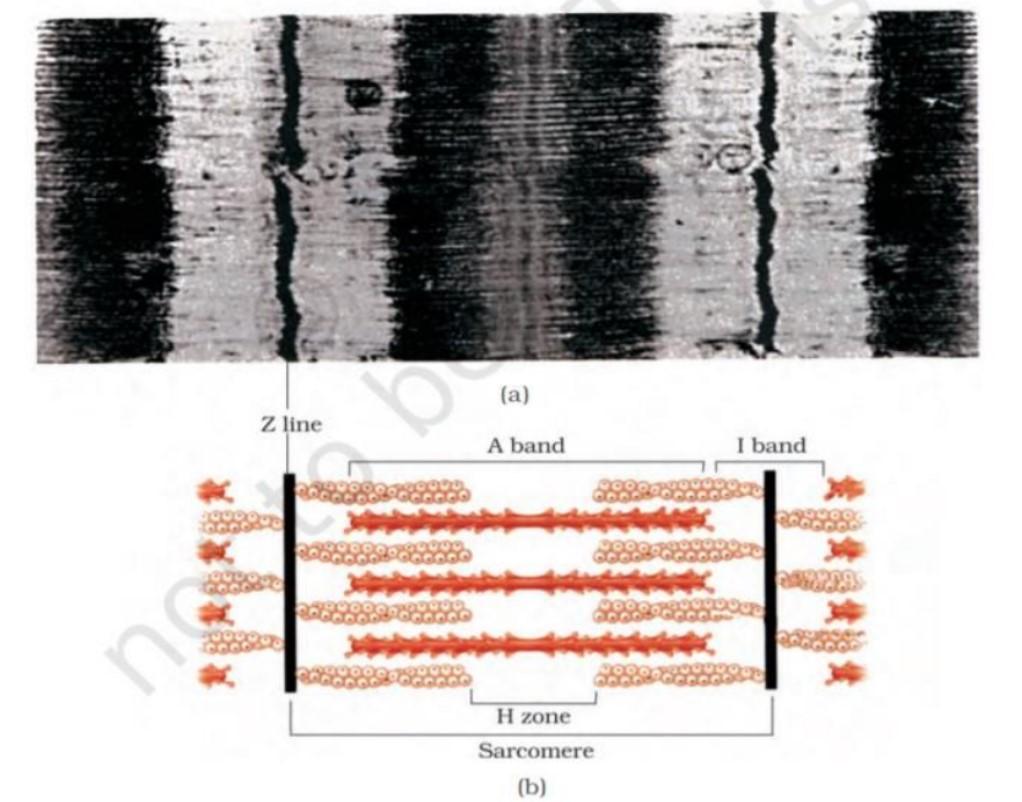
Muscle Contraction Mechanism
Actin and myosin filaments passing over one another causes muscle contraction. Hugh Huxley and Andrew Huxley proposed the sliding filament model. Sarcomere shortening and an increase in the overlap of thick and thin filaments are the results of sliding. Muscle contraction is the outcome of this. The stepwise muscle contraction mechanism is shown in the diagram below.

Skeletal System
Our body’s skeletal system aids in movement and locomotion and provides the structural framework. It shields the interior organs from harm. Bones and cartilage are two distinct types of connective tissues that make up our skeletal system.
Bones: A human adult is composed of 206 different types of bones. Whereas chondroitin salts are found in cartilage, calcium salts found in the matrix of bones make them hard. The axial skeleton, which consists of 80 bones, and the appendicular skeleton, which consists of 126 bones, make up the human skeleton.
Axial skeleton: ribs, sternum, head, and spinal column (80 bones).
Appendicular skeleton: pectoral and pelvic girdle, limbs (126 bones).
Joints: There are joints between bones as well as between cartilage and a bone. Joints facilitate mobility and movement. Various types of joints are given below.
- Pivot joint (between 1st and 2nd cervical vertebrae Atlas and Axis)
- Ball and socket joint (shoulder)
- Hinge joint (knee, elbow)
- Gliding joint (carpals)
- Saddle joint (In thumb, between carpal and metacarpal), etc.
Skeletal and Muscular System Disorders
The disorders along with their causes and symptoms of skeletal and muscular system is tabulated herein.
| Disease | Causes | Symptoms |
| Tetany | Calcium deficiency | Involuntary muscle contractions, spasm results due to continued contraction as the Ca ions transport back to the sarcoplasmic reticulum is affected. |
| Myasthenia Gravis | Autoimmune disease | Antibodies are produced against acetylcholine, causing weakening of muscles and paralysis. |
| Osteoarthritis | Due to injury, infection or any other disease | Inflammation in the joints. |
| Rheumatoid Arthritis | Autoimmune disease | Inflammation of joints due to the attack of one’s own immune system in joints. |
| Gout | Metabolic disorder due to increased uric acid | Uric acid crystals get deposited in the joints causing deformities, pain and inflammation. |
| Osteoporosis | Age-related, due to demineralization. Decreased estrogen level | Reduced bone mass leading to weakening of bones and frequent fractures. |
Locomotion and Motion Video Explanation
The detailed one shot video explanation on locomotion & movement chapter is given below. Our Expert NEET Faculty at Adda 247 have explained all the relevant concepts of this chapter in a lucid manner so that students won’t have to look for any other resources. The video contains explanation and different diagrams in 3D, so that students can have a clear understanding of all the mechanisms related to muscle movement and bones position. After going through the video explanation and PDF provided in this article, it is certain for students to score full marks from this chapter in the NEET exam.
Locomotion and Movement NEET Questions
As we know, the chapter on locomotion & movement has a very high weightage in the NEET exam. So, students must prepare for this chapter and its related question with full dedication. For this purpose, we have provided students with the one shot video and PDF link. Those video and PDF not only covers all the relevant concept of this chapter in detail as per the latest NCERT syllabus, but it also has many important MCQs for NEET exam. Some important questions regarding NEET from this chapter are listed below.
Q.1) This ion is responsible for unmasking of active sites for myosin or cross-bridge activity during muscle contraction
A) Potassium B) Magnesium
C) Calcium D) Sodium
Q.2) Lack of relaxation between successive stimuli in sustained muscle contraction is known as
A) fatigue B) tonus
C) tetanus D) spasm
Q.3) The upper ends of forearm bones articulate with each other by
A) Ball and Socket Joint B) Pivot Joint
C) Hinge Joint D) Ellipsoid Joint
Q.4) Which one of the following is a skull bone
A) Atlas B) Coracoid
C) Arytenoid D) Pterygoid
Q.5) In humans, during muscle contraction, the
A) actin filaments shorten B) A, I and H bands shorten
C) A band remains the same D) sarcomere does not shorten
Q.6) Which ions are involved in the muscle contraction?
A) Calcium and Magnesium Ions B) Calcium and Sodium Ions
C) Sodium and Potassium Ions D) Magnesium and Potassium Ions

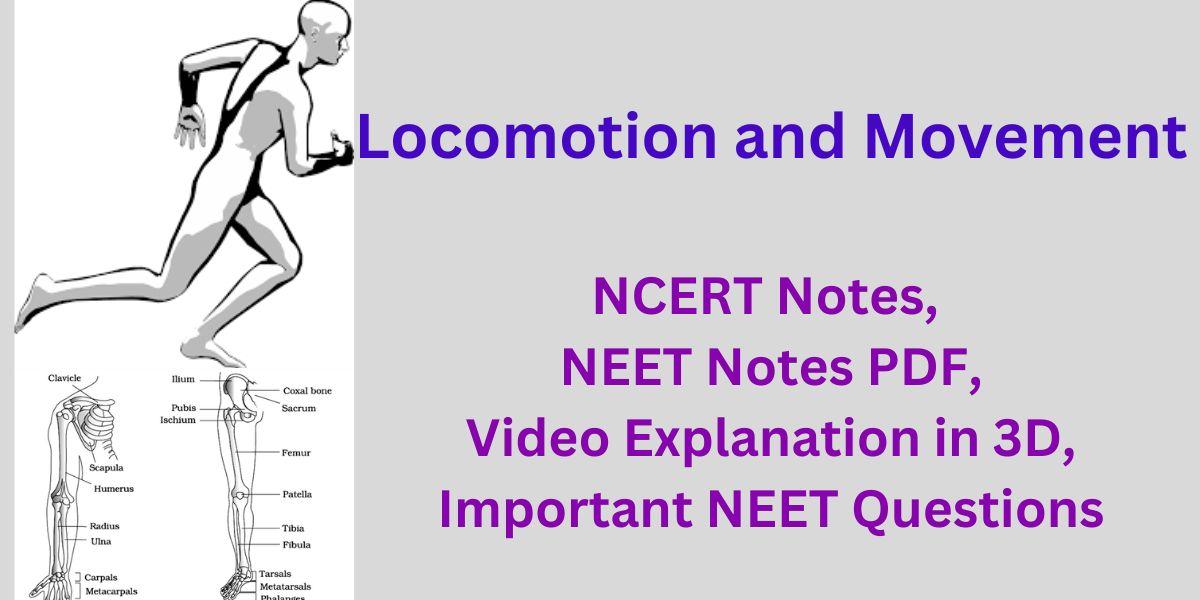



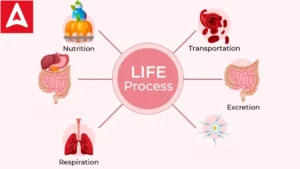 Life Processes: Check Nutrition, Transpo...
Life Processes: Check Nutrition, Transpo...
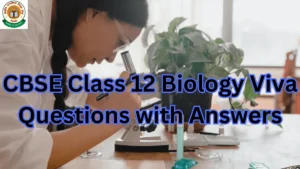 CBSE Class 12 Biology Viva Questions wit...
CBSE Class 12 Biology Viva Questions wit...
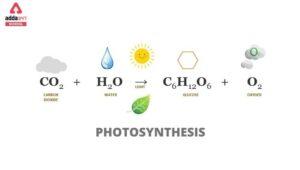 Photosynthesis: Equation, Reaction, Diag...
Photosynthesis: Equation, Reaction, Diag...










